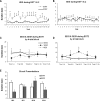Effects of stressor predictability on escape learning and sleep in mice
- PMID: 23449731
- PMCID: PMC3571750
- DOI: 10.5665/sleep.2464
Effects of stressor predictability on escape learning and sleep in mice
Abstract
Study objectives: Controllable stress, modeled by escapable shock (ES), can produce significant alterations in post-stress sleep, including increased rapid eye movement (REM) sleep. Recent work has demonstrated that post-stress sleep may be influenced by stressor predictability, modeled by predictive auditory cues. In this study, we trained mice with ES, either signaled (SES) or unsignaled (UES) by auditory cues, and investigated the effects of predictability on escape learning and sleep associated with ES.
Design: Adult male BALB/cJ mice were implanted for recording electroencephalography and activity via telemetry. After the mice recovered from surgery, baseline sleep recordings were obtained. The mice were then randomly assigned to SES and UES conditions. Both groups had control over the duration of footshocks (0.5 mA; 5.0 sec maximum duration) by moving to the non-occupied chamber in a shuttlebox. SES mice were presented tones (90 dB, 2 kHz, 10 sec maximum duration) that started 5.0 sec prior to and co-terminated with footshocks. UES mice were presented identical tones that were not synchronized to shock presentation. ES training continued for 2 consecutive days (EST1 and EST2) with 20 footshock presentations (1 min inter-stimulus intervals). Seven days after EST2, the animals were re-exposed to the training chamber (context) alone for 30 min.
Measurements and results: Escape latency was used to determine successful or unsuccessful escape learning. Sleep was scored for 20 h for baseline and on each treatment day. Freezing in the training context was scored as a behavioral index of fear. Nine of 14 SES mice successfully learned escape (SESl), and 5 failed to learn escape (SESf). Compared with baseline, SESl mice, but not SESf mice, showed significantly increased post-shock REM. All UES mice learned escape and showed enhanced post-shock REM. Freezing and sleep did not differ among groups on the context re-exposure day.
Conclusions: The results indicate that information available in a stressful situation can affect an animal's ability to learn an appropriate response and post-stress sleep.
Citation: Machida M; Yang L; Wellman LL; Sanford LD. Effects of stressor predictability on escape learning and sleep in mice. SLEEP 2013;36(3):421-430.
Keywords: Controllability; escape learning; mice; predictability; rapid eye movement (REM) sleep; sleep; stress.
Figures





References
-
- Penley JA, Tomaka J, Wiebe JS. The association of coping to physical and psychological health outcomes: a meta-analytic review. J Behav Med. 2002;25:551–603. - PubMed
-
- Yehuda R, Flory JD, Southwick S, Charney DS. Developing an agenda for translational studies of resilience and vulnerability following trauma exposure. Ann N Y Acad Sci. 2006;1071:379–96. - PubMed
-
- Natelson BH. Stress, hormones and disease. Physiol Behav. 2004;82:139–43. - PubMed
-
- Bolstad BR, Zinbarg RE. Sexual victimization, generalized perception of control, and posttraumatic stress disorder symptom severity. J Anxiety Disord. 1997;11:523–40. - PubMed
-
- Foa EB, Zinbarg R, Rothbaum BO. Uncontrollability and unpredictability in post-traumatic stress disorder: an animal model. Psychol Bull. 1992;112:218–38. - PubMed
Publication types
MeSH terms
Grants and funding
LinkOut - more resources
Full Text Sources
Other Literature Sources
Medical
Research Materials
Miscellaneous

